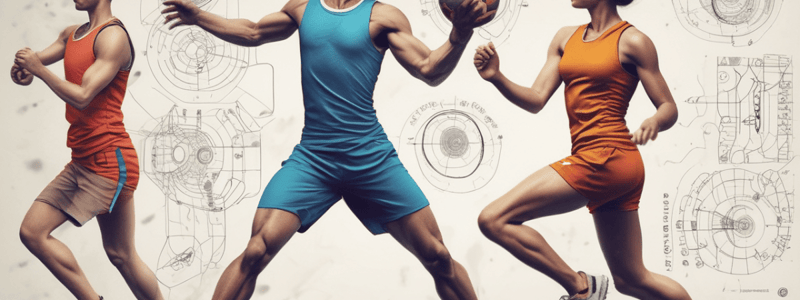Podcast
Questions and Answers
What is the primary role of feedback in motor skill development?
What is the primary role of feedback in motor skill development?
Feedback provides corrective guidance from instructors or peers, allowing individuals to refine and improve their motor skills.
What stage of motor skill development is characterized by the development of muscle memory and efficiency?
What stage of motor skill development is characterized by the development of muscle memory and efficiency?
The refinement stage is characterized by the development of muscle memory and efficiency.
How does practice influence motor skill development?
How does practice influence motor skill development?
Practice provides repetition and reinforcement of the skill, allowing individuals to develop and refine their motor skills.
What is the primary difference between intrinsic and extrinsic motivators in motor skill development?
What is the primary difference between intrinsic and extrinsic motivators in motor skill development?
How do individual differences influence motor skill development?
How do individual differences influence motor skill development?
What is the primary characteristic of a skill that has reached the automaticity stage of motor skill development?
What is the primary characteristic of a skill that has reached the automaticity stage of motor skill development?
What is the primary purpose of varied practice in physical education?
What is the primary purpose of varied practice in physical education?
How does fixed practice contribute to the development of motor skills in physical education?
How does fixed practice contribute to the development of motor skills in physical education?
What is the significance of feedback in motor skill development in physical education?
What is the significance of feedback in motor skill development in physical education?
How does the use of varied practice and fixed practice differ in terms of motor skill development?
How does the use of varied practice and fixed practice differ in terms of motor skill development?
What is the benefit of incorporating both varied practice and fixed practice in a physical education program?
What is the benefit of incorporating both varied practice and fixed practice in a physical education program?
What is the main distinction between fixed practice and varied practice in physical education?
What is the main distinction between fixed practice and varied practice in physical education?
How does the automaticity stage of motor skill development impact performance in physical education?
How does the automaticity stage of motor skill development impact performance in physical education?
What is the primary advantage of incorporating both fixed and varied practice in a physical education program?
What is the primary advantage of incorporating both fixed and varied practice in a physical education program?
What role does motivation play in the development of motor skills in physical education?
What role does motivation play in the development of motor skills in physical education?
How does the OCR A level specification approach the concept of motor skill development in physical education?
How does the OCR A level specification approach the concept of motor skill development in physical education?
Flashcards are hidden until you start studying
Study Notes
Skills Classification in Physical Education
Skill Classification Models
- Glover's Classification Model:
- Categorizes skills into three groups:
- Discrete skills: Isolated movements with a clear beginning and end (e.g., jumping, throwing)
- Serial skills: Combinations of discrete skills performed in a sequence (e.g., dribbling a basketball)
- Continuous skills: Ongoing movements with no clear beginning or end (e.g., running, swimming)
- Categorizes skills into three groups:
- Magill's Classification Model:
- Divides skills into two categories:
- Closed skills: Performed in a predictable, controlled environment (e.g., shooting a free throw)
- Open skills: Performed in a dynamic, unpredictable environment (e.g., playing tennis)
- Divides skills into two categories:
Motor Skill Development
- Stages of Motor Skill Development:
- Initiation: Introduction to a new skill
- Acquisition: Practice and refinement of the skill
- Refinement: Development of muscle memory and efficiency
- Automaticity: Mastery of the skill, allowing for focus on other aspects of performance
- Factors Influencing Motor Skill Development:
- Practice: Repetition and reinforcement of the skill
- Feedback: Corrective guidance from instructors or peers
- Motivation: Intrinsic and extrinsic motivators (e.g., enjoyment, rewards)
- Individual Differences: Variations in ability, age, and experience
Studying That Suits You
Use AI to generate personalized quizzes and flashcards to suit your learning preferences.




